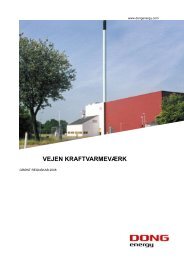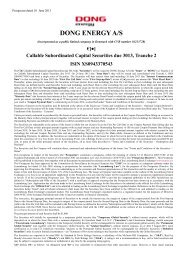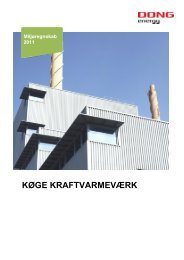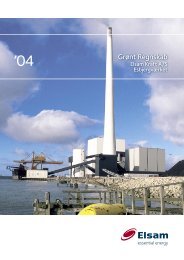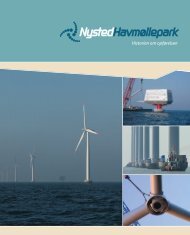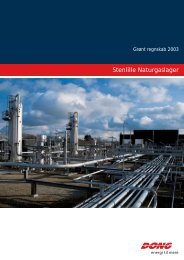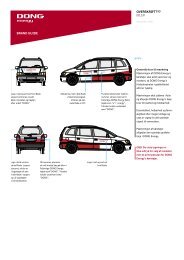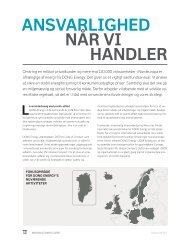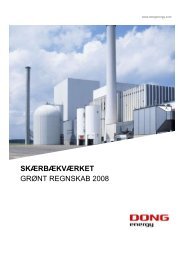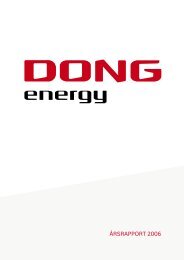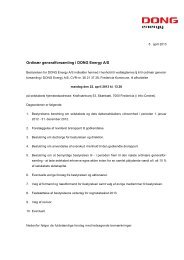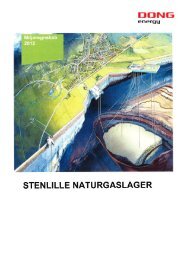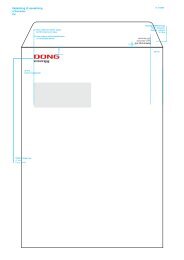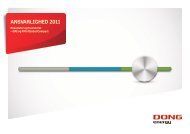ANNUAL REPORT 2011 - DONG Energy
ANNUAL REPORT 2011 - DONG Energy
ANNUAL REPORT 2011 - DONG Energy
You also want an ePaper? Increase the reach of your titles
YUMPU automatically turns print PDFs into web optimized ePapers that Google loves.
notes<br />
18 Financial risks<br />
At 31 December <strong>2011</strong>, unrealised value adjustments of derivative<br />
financial instruments for currency hedging of recognised<br />
assets and liabilities totalled DKK -775 million (31 December<br />
2010: DKK -100 million).<br />
sensitivity analysis<br />
<strong>DONG</strong> <strong>Energy</strong> A/S’s principal currency risks relate to USD,<br />
GBP, SEK and NOK. The company also calculates and manages<br />
the currency risk vis-à-vis EUR. However, as price fluctuations<br />
between DKK and EUR are small, the risk is considered<br />
to be insignificant.<br />
All other conditions being equal, a 10% increase in the USD<br />
exchange rate in relation to the exchange rate at the balance<br />
sheet date would have had a negative effect of DKK 180 million<br />
on profit and equity (2010: positive effect of DKK 236 million).<br />
All other conditions being equal, a decrease in the exchange<br />
rate would have had a corresponding opposite impact.<br />
All other conditions being equal, a 10% increase in the GBP<br />
exchange rate in relation to the exchange rate at the balance<br />
sheet date would have had a negative effect of DKK 379 million<br />
on profit and equity (2010: negative effect of DKK 369<br />
million). All other conditions being equal, a decrease in the exchange<br />
rate would have had a corresponding opposite impact.<br />
All other conditions being equal, a 10% increase in the SEK<br />
exchange rate in relation to the exchange rate at the balance<br />
sheet date would have had a negative effect of DKK 140 million<br />
on profit and equity (2010: negative effect of DKK 155 million).<br />
All other conditions being equal, a decrease in the exchange<br />
rate would have had a corresponding opposite impact.<br />
All other conditions being equal, a 10% increase in the NOK<br />
exchange rate in relation to the exchange rate at the balance<br />
sheet date would have had a positive effect of DKK 461 million<br />
on profit and equity (2010: positive effect of DKK 393 million).<br />
All other conditions being equal, a decrease in the exchange<br />
rate would have had a corresponding opposite impact.<br />
Interest rate risks<br />
Interest rate risks are the risk that externally introduced<br />
changes in agreed interest rates lead to increased interest<br />
expense or reduced interest income for <strong>DONG</strong> <strong>Energy</strong> A/S. For<br />
an analysis of the company’s interest rate sensitivity, reference<br />
is made to note 32 to the consolidated financial statements.<br />
ineffectiveness<br />
Ineffectiveness of interest rate hedging was DKK 0 million in<br />
<strong>2011</strong> (2010: DKK 0 million).<br />
interest rate hedges<br />
As part of its financial management, <strong>DONG</strong> <strong>Energy</strong> A/S swaps<br />
the interest basis on loans from a floating rate to a fixed rate or<br />
vice versa using interest rate swaps. For interest rate swaps<br />
converting floating-rate loans to fixed-rate loans (hedging of<br />
cash flows), value adjustments recognised directly in equity at<br />
31 December <strong>2011</strong> amounted to a net loss of DKK 848 million<br />
(31 December 2010: loss of DKK 265 million). Reference is<br />
made to note 33 to the consolidated financial statements.<br />
Counterparty risks<br />
178 parEnt COmpany finanCial statEmEnts – <strong>DONG</strong> ENERGY <strong>ANNUAL</strong> <strong>REPORT</strong> <strong>2011</strong><br />
Counterparty risks are the risk that a financial loss will be<br />
realised in the event of a counterparty to an agreement being<br />
unable to discharge its obligations under the agreement.<br />
<strong>DONG</strong> <strong>Energy</strong> A/S’s counterparty risk comprises primarily<br />
receivables from financial counterparties. Credit rating of business<br />
partners is carried out on a regular basis to generally<br />
minimise this risk.<br />
The amounts with which the items in question are recognised<br />
in the balance sheet correspond to the company’s maximum<br />
counterparty risk. Losses on receivables from individual business<br />
partners have historically been low. In the company’s<br />
opinion, there are no special concentrations of counterparty<br />
risks. The company’s counterparty risk in connection with<br />
derivative financial instruments entered into is limited as such<br />
instruments have primarily been entered into with major international<br />
banks or other counterparties with a high credit rating.<br />
Reference is made to note 32 to the consolidated financial<br />
statements.



